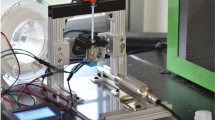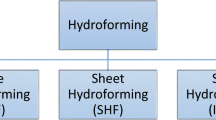Abstract
Solidification cracking (SC) is a defect that has been extensively studied in welding and casting and, consequently, standardized testing methods to quantify cracking have been developed for these processes. However, additive manufacturing (AM) processes currently lack any such test. The objective of the current study is to outline the development of a first-of-its-kind solidification cracking test for AM in the form of a benchmark specimen which aims to standardize quantification of solidification cracking in AM. This test serves as a novel method of crack quantification that specifically addresses the unique process characteristics of AM, such as scan strategy, geometric limitations, and layer reheating, as opposed to adopting tests designed for traditional manufacturing processes. The benchmark design utilized self-restraint to induce cracking at pre-defined locations, and was printed from Inconel 625 and 718 using laser directed energy deposition. Crack severity was quantified by optical microscopy, and it was found that the ratio of the linear crack length to the total crack length was consistently between 0.8 and 0.9. Further characterization revealed that the cracks propagated transgranularly along the melt pool boundaries. The commercially available finite-element software package Simufact Welding was used to simulate printing of the benchmark specimen using the directed energy deposition module and confirmed high levels of stress at the crack initiation locations. Based on the characterization and simulation results, it was determined that the cause of the observed cracks was likely due to ductile fracture rather than solidification cracks. Nevertheless, the benchmark was able to show a difference in the level of cracking between alloys and the ability to initiate cracks at pre-defined locations using geometrically induced restraint. Thus, it was concluded that while the existing benchmark design demonstrated progress towards a standardized test, further refinement to the design in order to improve reliability of SC formation is required.

















Similar content being viewed by others
References
Eskin DG, Katgerman L (2004) Mechanical properties in the semi-solid state and hot tearing of aluminium alloys. Prog Mater Sci 49:629–711. https://doi.org/10.1016/S0079-6425(03)00037-9
Kou S (2015) A simple index for predicting the susceptibility to solidification cracking. Weld J 94:374–388
Benoit MJ, Mazur M, Easton MA, Brandt M (2021) Effect of alloy composition and laser powder bed fusion parameters on the defect formation and mechanical properties of Inconel 625. Int J Adv Manuf Technol 114:915–927. https://doi.org/10.1007/s00170-021-06957-z
Lundin C, Savage W (1965) The varestraint test. Weld J Res Suppl 44:433-s–442-s
International Organization for Standardization (2005) ISO/TR 17641-3:2005 destructive tests on welds in metallic materials—hot cracking tests for weldments—arc welding processes—part 3: externally loaded tests
Cao G, Kou S (2006) Hot cracking of binary Mg–Al alloy castings. Mater Sci Eng A 417:230–238. https://doi.org/10.1016/j.msea.2005.10.050
Kannengiesser T, Boellinghaus T (2014) Hot cracking tests—an overview of present technologies and applications. Weld World 58:397–421. https://doi.org/10.1007/s40194-014-0126-y
Wall A, Benoit MJ (2023) A review of existing solidification crack tests and analysis of their transferability to additive manufacturing. J Mater Process Technol 320:118090
AMB2018–01 Description, NIST (2018). https://www.nist.gov/ambench/amb2018-01-description. Accessed 19 May 2023
Yang Y, Allen M, London T, Oancea V (2019) Residual strain predictions for a powder bed fusion inconel 625 single cantilever part. Integr Mater Manuf Innov 8:294–304. https://doi.org/10.1007/s40192-019-00144-5
Houldcroft PT (1955) A simple cracking test for use with argon-arc welding. Br Weld J 2:471–475
Mazur M, Benoit M, Easton M, Brandt M (2020) Selective laser melting of Inconel 625 alloy with reduced defect formation. J Laser Appl 32:022058. https://doi.org/10.2351/7.0000093
Xia C, Kou S (2020) Evaluating susceptibility of Ni-base alloys to solidification cracking by transverse-motion weldability test. Sci Technol Weld Join 25:690–697. https://doi.org/10.1080/13621718.2020.1802897
Rappaz M, Drezet J-M, Grasso P, Jacot A, Stefanescu D (2003) Hot tearing and coalescence: two deeply-connected phenomena. Model Cast Weld Adv Solidif Process 53–60
Carter LN, Attallah MM, Reed RC (2012) Laser powder bed fabrication of nickel-base superalloys: influence of parameters; characterisation, quantification and mitigation of cracking. Superalloys 2012(6):2826–2834
Liu F, Lin X, Huang C, Song M, Yang G, Chen J, Huang W (2011) The effect of laser scanning path on microstructures and mechanical properties of laser solid formed nickel-base superalloy Inconel 718. J Alloys Compd 509:4505–4509. https://doi.org/10.1016/j.jallcom.2010.11.176
Liu Q, Fang L, Xiong Z, Yang J, Tan Y, Liu Y, Zhang Y, Tan Q, Hao C, Cao L, Li J, Gao Z (2021) The response of dislocations, low angle grain boundaries and high angle grain boundaries at high strain rates. Mater Sci Eng A 822:141704. https://doi.org/10.1016/j.msea.2021.141704
Katgerman L, Eskin DG (2008) In search of the prediction of hot cracking in aluminium alloys. In: Bollinghaus T, Herold H, Cross CE, Lippold JC (eds) Hot cracking phenomena in welds II. Springer, Berlin
Rombouts M, Maes G, Mertens M, Hendrix W (2012) Laser metal deposition of Inconel 625: microstructure and mechanical properties. J Laser Appl 24:052007. https://doi.org/10.2351/1.4757717
Dubiel B, Sieniawski J (2019) Precipitates in additively manufactured Inconel 625 superalloy. Materials 12:1144. https://doi.org/10.3390/ma12071144
Luskin TC (2013) Investigation of weldability in high-Cr Ni-base filler metals, Ph.D. Thesis. The Ohio State University
Cieslak M (1991) The welding and solidification metallurgy of alloy 625. Weld J Res Suppl 2:49–56
Kou S (2015) A criterion for cracking during solidification. Acta Mater 88:366–374. https://doi.org/10.1016/j.actamat.2015.01.034
Kou S (2003) Solidification and liquation cracking issues in welding. Jom 55:37–42
Yang J, Li F, Wang Z, Zeng X (2015) Cracking behavior and control of Rene 104 superalloy produced by direct laser fabrication. J Mater Process Technol 225:229–239. https://doi.org/10.1016/j.jmatprotec.2015.06.002
Zhou Z, Huang L, Shang Y, Li Y, Jiang L, Lei Q (2018) Causes analysis on cracks in nickel-based single crystal superalloy fabricated by laser powder deposition additive manufacturing. Mater Des 160:1238–1249. https://doi.org/10.1016/j.matdes.2018.10.042
Chen Y, Lu F, Zhang K, Nie P, Elmi Hosseini SR, Feng K, Li Z (2016) Dendritic microstructure and hot cracking of laser additive manufactured Inconel 718 under improved base cooling. J Alloys Compd 670:312–321. https://doi.org/10.1016/j.jallcom.2016.01.250
Han Q, Mertens R, Montero-Sistiaga ML, Yang S, Setchi R, Vanmeensel K, Van Hooreweder B, Evans SL, Fan H (2018) Laser powder bed fusion of Hastelloy X: effects of hot isostatic pressing and the hot cracking mechanism. Mater Sci Eng A 732:228–239. https://doi.org/10.1016/j.msea.2018.07.008
Mouritz AP (2012) Fracture processes of aerospace materials. Introd Aerosp Mater 428:453. https://doi.org/10.1533/9780857095152.428
Young GA, Capobianco TE, Penik MA, Morris BW, McGee JJ (2008) The Mechanism of Ductility Dip Cracking in Nickel-Chromium Alloys. Weld J N Y 87(2):31
Pereira FG, Lourenço JM, Nascimento RM, Castro NA (2018) Fracture behavior and fatigue performance of Inconel 625. Mater Res 25(21):e20171089. https://doi.org/10.1590/1980-5373-mr-2017-1089
Luther SJ, Alexandrov BT, McCracken SL, Tatman JK (2022) Correlation of imposed mechanical energy with ductility-dip cracking in a highly restrained weld of Alloy 52. J Manuf Process 79:767–788. https://doi.org/10.1016/j.jmapro.2022.05.027
Suyitno KWH, Katgerman L (2009) Integrated approach for prediction of hot tearing. Metall Mater Trans A 40:2388–2400
Acknowledgements
The authors would like to acknowledge the financial assistance of NSERC Discovery Grant program (RGPIN-2021-02892) and UBC Okanagan Aspire fund (AWD-016845). The authors of this paper would also like to acknowledge the support of the following individuals and organisations: Dr. Sudip Shrestha and the FiLTER laboratory for assistance with SEM, EDS, and EBSD imaging, Ms. Emma Pugsley of Liburdi Automation Inc. for assistance in design optimisation and fabrication, and Dr. Matthew Brown of UBCO for performing XRD procedures and assisting with analysis.
Funding
NSERC Discovery Grant, RGPIN-2021-02892, Michael J. Benoit, UBC Okanagan Aspire fund, AWD-016845, Michael J. Benoit.
Author information
Authors and Affiliations
Corresponding author
Ethics declarations
Conflict of interest
On behalf of all the authors, the corresponding author states that there is no conflict of interest.
Additional information
Publisher's Note
Springer Nature remains neutral with regard to jurisdictional claims in published maps and institutional affiliations.
Rights and permissions
Springer Nature or its licensor (e.g. a society or other partner) holds exclusive rights to this article under a publishing agreement with the author(s) or other rightsholder(s); author self-archiving of the accepted manuscript version of this article is solely governed by the terms of such publishing agreement and applicable law.
About this article
Cite this article
Wall, A., Dong, T. & Benoit, M.J. On the development of a novel benchmark design for crack quantification in additive manufacturing. Prog Addit Manuf (2024). https://doi.org/10.1007/s40964-024-00596-y
Received:
Accepted:
Published:
DOI: https://doi.org/10.1007/s40964-024-00596-y




